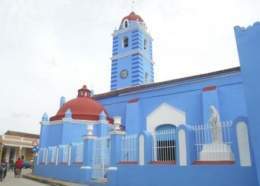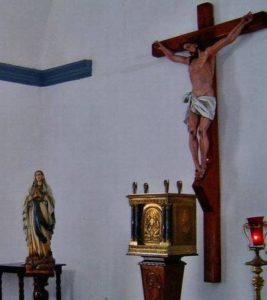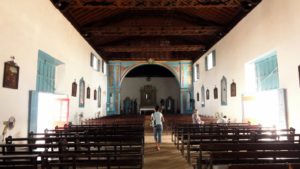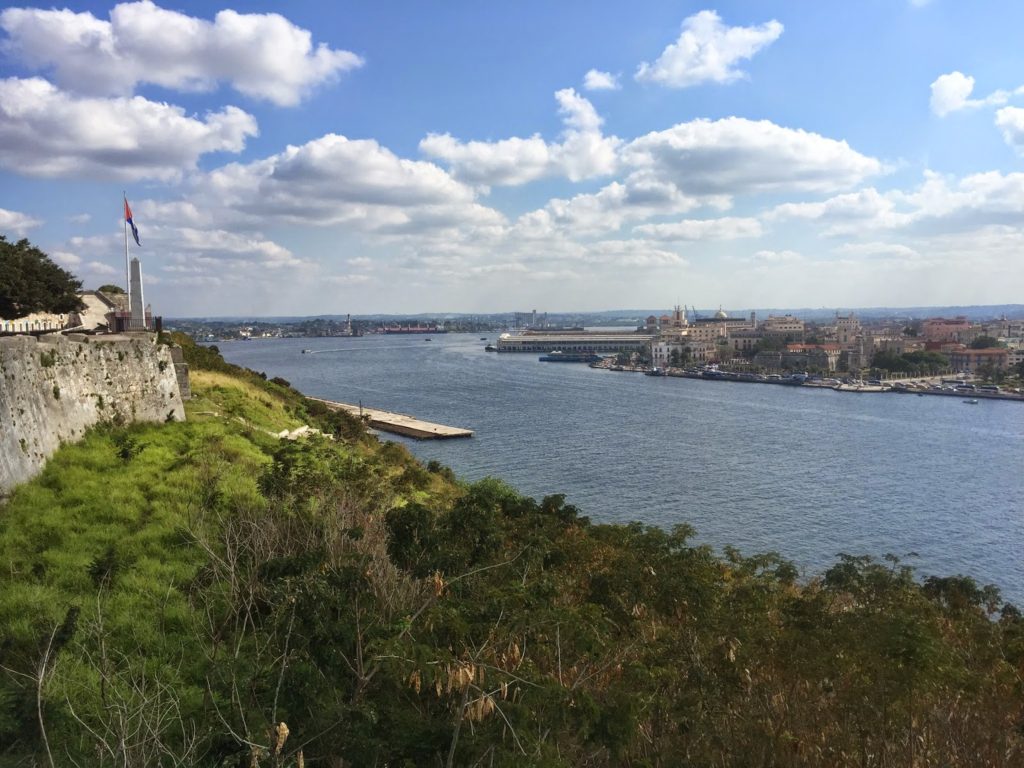The Mayor Parish Church, oldest building is located in the heart of the historic center of Sancti Spíritus of the former village founded in 1514 and saved to its ancient walls legends and mysteries that are intertwined with the reality.
This national monument, which has the privilege of having an arc that separates the nave from the presbytery, considered unique of its kind in Cuba, has a rich history that has become a cultural and architectural testament to the island.
Dissimilar are the stories surrounding this enigmatic Temple. One of them is closely related to the beautiful “Chapel of the humility and patience”, named so for the image of Christ which was placed on the altar.
The unknown sculptor of the Altar.
They say the espirituanos a traveler, which name is not known, which designed the sculpture in 1698 and it remained for more than one month locked in place to project the figure. While working, the mysterious man covered with a huge curtain the altar, so that no one saw his masterpiece until it was not completed.
It narrates the legend that a strong storm took a very dark night and we heard thundering electric shock. The next morning the artist had gone like dust in the wind, but had instead been carved the beautiful figure.
Legend of the golden rooster/Paloma.
According to the story, the chapel of the Rosary made it build the captain Pérez de Corcha, a wealthy landowner who donated to the Temple a beautiful Golden Cockerel, so you adorn the altar forever and there, a year later, buried, complying with the custom of the time to make burials in these religious centers.
One of the most recognized espirituanos historians, second Marin Garcia, says that the real and the fictional in terms of the origin of the money used in the construction of that ship, mix there are two versions.
One says that the chieftain of Magon (district india), grateful for the treatment received by the ancestors of Perez coverings, especially his father, bequeathed his treasure on the death of their protective cases. Other legendary versions ensures that the captain Pérez de Corcha – who lived 90 years – inherited property of the Indian, “because he was a descendant of this line”; but in 1665, a band of pirates, led by Pedro Legrand French stormed the villa of the Holy Spirit, and – of course – that the objects of the main parish church were among the most coveted treasures. The beautiful Golden Cockerel was stolen and the assailants set fire to place files.
Some say that the enigmatic Golden Cockerel was a dove representing the Holy Spirit of God, hence the name of the fourth town of Cuba, Sancti Spíritus.
The Guije of the Tunnel.
Guije, one of the most representative of this Cuban region of the imaginary and the popular legend figures, usually many times be associated with rural areas, especially in places like rivers and ponds, but in historical legend the guije appears linked to a city area in particular the altar of the Church parish increased from Sancti Spiritus.
Described as a bold Cabezón of Googly-Eyed and disheveled hair, they say that the guije appeared in the temple, where he crossed the altar and then returned to the underground tunnel that went from the main parish church and who came out on the banks of the Yayabo River. The legend says that one day the Guije ceased to appear in Sancti Spíritus leaving behind its usual tour of the temple forever, but was delighted his quick presence legend, sometimes grotesque and unholy, other times of blessing.
He has the myth that men, women and children in times of these religious celebrations used to go for pilgrimage to the river and bring offerings to avoid its mischievousness.
Agencies/Rad.Encyclopedia/Wiki/Internet Photos/Arnold Varona / TheCubanHistory.com
THE CUBAN HISTORY, HOLLYWOOD.
LA COLONIAL IGLESIA PARROQUIAL MAYOR DE SANCTI SPIRITUS, UN LUGAR DE LEYENDAS.
En el corazón del centro histórico urbano de Sancti Spíritus se halla la Iglesia Parroquial Mayor, construcción más antigua de la otrora villa fundada en 1514 y que guarda en sus añejos muros leyendas y misterios que se entrelazan con la realidad.
Este Monumento Nacional, que tiene el privilegio de contar con un arco que separa la nave del presbiterio, considerado único de su tipo en Cuba, atesora una rica historia que la convierte en un testimonio cultural y arquitectónico de la Isla.
Disímiles son las historias que rodean a este enigmático templo. Una de ellas está muy relacionada con la hermosa “Capilla de la humildad y paciencia”, nombrada así por la imagen de Cristo que fue colocada en su altar.
El desconocido escultor del Altar.
Dicen los espirituanos que un viajero, del cual no se conoce el nombre, fue el que diseñó la escultura en 1698 y que permaneció por más de un mes encerrado en aquel lugar para proyectar la figura. Mientras trabajaba, el misterioso hombre cubrió con una inmensa cortina el altar, para que nadie viese su obra maestra hasta que no fuese terminada.
Narra la leyenda que una fuerte tempestad se adueñó de una noche muy oscura y que se escucharon estruendosas descargas eléctricas. A la mañana siguiente el artista había desaparecido como polvo en el viento, pero en su lugar había quedado tallada la hermosa figura.
Leyenda del Gallo/Paloma de Oro.
De acuerdo con la historia, la Capilla del Rosario la hizo edificar el Capitán Pérez de Corcha un rico hacendado que donó al templo un bello gallo de oro, para que adornara por siempre el altar y allí, un año más tarde, fue sepultado, cumpliendo con la costumbre de la época de hacer enterramientos en estos centros religiosos.
Uno de los historiadores espirituanos más reconocidos, Segundo Marín García, afirma que se mezclan lo real y lo novelesco en cuanto a la procedencia del dinero usado en la construcción de esa nave, al existir dos versiones.
Una afirma que el Cacique de Magón (comarca india), agradecido por el trato recibido por parte de los antecesores de Pérez de Corcha, en especial de su padre, legó su tesoro al morir a sus supuestos protectores. Otra de las versiones legendarias asegura que el capitán Pérez de Corcha -que vivió 90 años- heredó los bienes del indio, “porque era descendiente de este por línea materna”; pero en 1665, una banda de piratas, dirigidos por el francés Pedro Legrand asaltó la villa del Espíritu Santo y —por supuesto— que los objetos de la Iglesia Parroquial Mayor estuvieron entre los tesoros más codiciados. El hermoso gallo de oro fue robado y los asaltantes prendieron fuego a los archivos del lugar.
Dicen algunos que aquel enigmático gallo de oro era una paloma que representaba el Espíritu Santo de Dios, de ahí el nombre de la cuarta villa de Cuba, Sancti Spiritus.
El güije del túnel.
El güije, una de las figuras del imaginario y de la leyenda popular más representativas de esta región cubana, suele asociarse muchas veces a las zonas rurales, especialmente en lugares como ríos y charcas, pero en la leyenda histórica el güije aparece ligado a una zona citadina en particular el altar de la Iglesia Parroquial Mayor de Sancti Spíritus.
Descrito como un negrito cabezón, de ojos saltones y cabello desaliñado, cuentan que el güije aparecía en el templo, desde donde atravesaba el altar y volvía después al túnel subterráneo que iba desde la Iglesia Parroquial Mayor y que salía a orillas del río Yayabo. Cuenta la leyenda que un dia el Güije dejó de aparecer en Sancti Spíritus dejando atrás su recorrido habitual del templo para siempre, pero quedó la leyenda encantada de su rápida presencia, unas veces grotesca y profana, otras veces de bendición.
Cuenta el mito que hombres, mujeres y niños en tiempos de estas celebraciones religiosas acostumbraban ir de peregrinación hasta el río y llevarle ofrendas para evitar sus malicias.
Agencies/Rad.Encyclopedia/Wiki/Internet Photos/Arnoldo Varona/ TheCubanHistory.com
THE CUBAN HISTORY, HOLLYWOOD.







